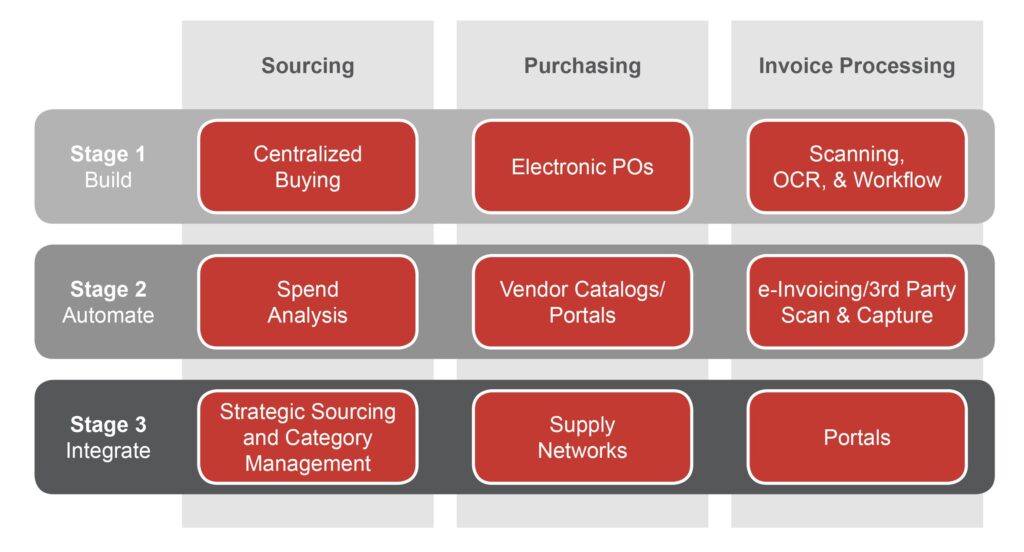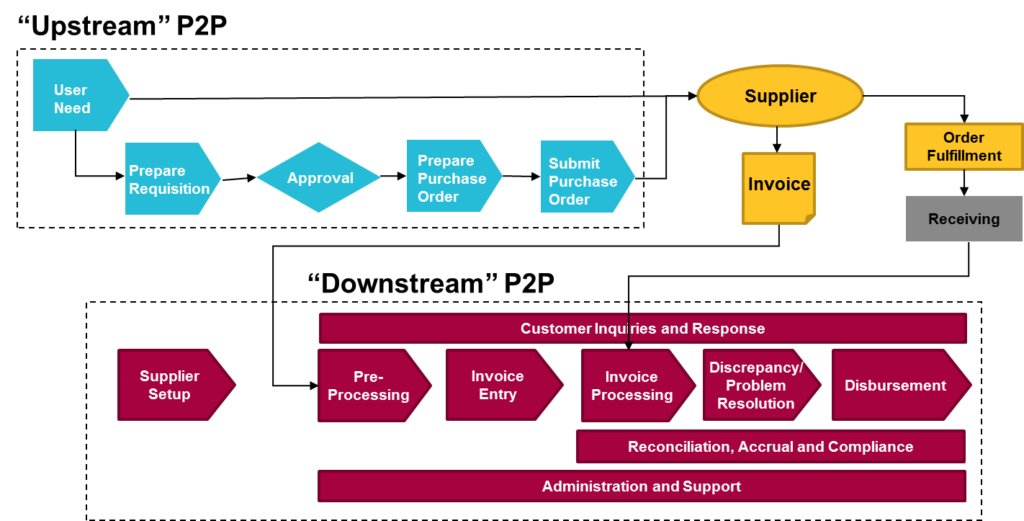
A Fortune 100 pharmaceutical company sought outside perspective to perform an assessment of its internal procure-to-pay (P2P) operations. Once the appropriate measures were in place, management wanted to identify initiatives that would improve the efficiency and effectiveness of this process.
ScottMadden was retained by the client to determine how well its P2P practices compared with those of leading organizations. ScottMadden then developed recommendations designed to transform the client’s current P2P process.
The client’s management wanted to determine how well its current P2P practices compared to those of external leading companies (both pharmaceutical and non-pharmaceutical).
To properly assess the P2P process, the ScottMadden team assembled proprietary and externally available benchmarks and leading practices for purchasing and accounts payable and then compared these to the internal practices of the client. The team conducted site visits to shadow and interview key accounts payable and purchasing personnel, and they collected performance data and practice information related to the client’s current P2P process.
The ScottMadden team followed their “P2P Excellence” methodology, but limited the scope of the review to a high-level assessment of current state practices coupled with a partial gap analysis.
Figure 1: The ScottMadden P2P Excellence Methodology

ScottMadden had a history of successful projects with this client. For this specific project, the client wanted deep involvement by partner-level consultants to conduct a thorough, but practical, analysis and to develop actionable recommendations. ScottMadden leveraged its robust P2P experience and brought top supply chain experts, as well as a large database of P2P leading practices and performance benchmarks, to the project.
Leading Practice Gap Analysis
To better understand the nature of the P2P environment and workflow, the ScottMadden team utilized an analytical framework consisting of four categories: 1) people and organization, 2) policy and process, 3) tools and technology, and 4) data and knowledge. Leading practices were examined under each of these categories.
Figure 2: Framework for P2P Excellence

Elements in each category were compared to the client’s ongoing practices. ScottMadden facilitated the evaluation of these practices on two scales: 1) breadth of usage and 2) depth and extent of usage. This assessment allowed ScottMadden to compare the client’s adoption of leading practices to those of other companies and locate the client on ScottMadden’s “P2P Maturity Model.” This three-stage model (shown in Figure 3) depicts the P2P practices adopted by companies as they move from the initial P2P building blocks to an integrated P2P model.
Figure 3: The ScottMadden P2P Maturity Model

As often happens, the client’s current practices fell within different stages of the maturity model, but they were mostly identified with those companies at a “Stage 1” level of maturity. The opportunity for this client was in adopting practices that would help them move to “Stage 2” or further.
Issue/Problem Identification
The ScottMadden team also examined in detail the client’s current state organizational design and business practices related to the P2P process. In conducting this analysis, the team divided the client’s practices into “upstream” and “downstream.” Upstream practices or processes began with user-requisitioning and ended with the submission of a complete purchase order. Downstream practices or processes began with supplier setup and ended with supplier payment as shown in Figure 4.
Figure 4: P2P Process Overview

Over the past several years, the client’s volume of upstream P2P transactions had increased significantly due to organic and merger growth. This increased workload was putting pressure on both the upstream and downstream processes and associated organizations. Upstream P2P practices were clearly affecting downstream cost, productivity, and quality.
Downstream P2P efficiency was being impacted by three factors:
Improvement Recommendations
Following the comparison of the client’s performance (metric benchmarking) and adoption rate of leading practices (practice benchmarking), the ScottMadden team identified a range of recommendations designed to move the client to the next stage of P2P maturity. Recommendations included: 1) increasing the volume of spend channeled through approved suppliers, 2) enforcing greater use of purchasing processes that are advantageous to the company as a whole, 3) establishing a more robust P2P governance structure, and 4) tracking executive-level metrics separately for each business division and for the client as a whole using a simple scorecard that highlights key comparisons and trends. An example of the performance scorecard is shown in Figure 5.
Figure 5: P2P Performance Scorecard



Implementation Support
Following the assessment, ScottMadden assisted this client by preparing written policies that mandated compliance with corporate purchasing standards. ScottMadden created a “Directed Sourcing Matrix,” which listed how goods and services within each spend category should be acquired and paid for. ScottMadden also designed a process for improved tracking and reporting of purchasing compliance.
The ScottMadden team and client executives were excited about the identification of key opportunities to improve the efficiency and effectiveness of their P2P process. Because of the organizational change management and project management provided, the organization has begun to work more collaboratively and has demonstrated improvements in key P2P metrics. The fact that progress is being made is a testament to the passion and commitment of key managers driving upstream and downstream P2P changes.
View MoreSussex Economic Advisors is now part of ScottMadden. We invite you to learn more about our expanded firm. Please use the Contact Us form to request additional information.